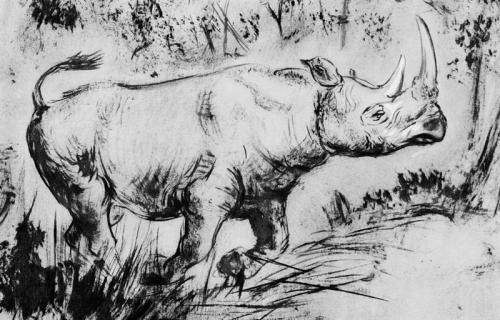Liverpool John Moores University
Source - http://phys.org/news/2015-01-extinct-rhino-habits-reconstructions-ice.html

Reconstruction of a ‘forest’ rhinoceros. The horizontal orientation of the head points to a preference for a diet rich in leaves. Credit: K. Hübner.
A study into the feeding behaviour of two extinct European rhinoceros species has revealed an unexpected survival strategy for a mammalian family of the Ice Ages. The new findings published in the journal Quaternary Science Reviews showed that the rhinos had the ability to change their diet regardless of their dietary specialisation, for example when the climate changed. Based on these surprising findings, reconstructions of the Ice Age environments, which were partly based on the diet assumed for these rhinoceroses, must also be reconsidered.
Liverpool John Moores University's (LJMU's) Dr Eline van Asperen from the Research Centre in Evolutionary Anthropology and Palaeoecology, worked alongside Ice Age palaeontologist Professor Dr Ralf-Dietrich Kahlke of the Senckenberg Research Station of Quaternary Palaeontology in Weimar (Germany) to investigate the feeding behaviour of the extinct European 'forest' rhinoceros Stephanorhinus kirchbergensis and 'steppe' rhinoceros Stephanorhinus hemitoechus.
Using a wide range of find spots, the German-British team established that the extinct rhinoceros species followed their food preferences when food resources were plentiful and varied, but when available food sources were more uniform, they were able to skip their 'ecological imprint' and to take what was available. They concluded that the feeding habits of the so-called 'forest' and 'steppe' rhinoceros did not necessarily reflect the habitats from which they derive their names.
Dr van Asperen and Professor Kahlke studied the fossil teeth of more than 200 individual rhinoceroses of between 350,000 and 100,000 years old from a wide range of find spots in Germany and the United Kingdom. They reconstructed the food spectrum of these extinct animals using the 'mesowear method', which is based on the fact that different foodstuffs lead to different wear patterns on the teeth.
The extant African black rhinoceros preferentially subsists on soft plant foods – its diet consists mainly of leaves, which it strips off branches and twigs. The African native white rhinoceros, in contrast, is fully adapted to eating coarse grass. For the extinct European rhinoceros species Stephanorhinus kirchbergensis and Stephanorhinus hemitoechus , a similarly specialised feeding strategy had been assumed, but the research found that they were considerably more flexible in their diet in extreme conditions.
The 'forest' rhinoceros Stephanorhinus kirchbergensis , which originated in Asia, was larger than all extant rhinoceroses and "both the shape of its teeth and the way its head is connected to its vertebral column indicate a preference for feeding in forests", says Kahlke. The somewhat smaller 'steppe' rhinoceros Stephanorhinus hemitoechus , in contrast, held its head much lower – this, as well as the shape of its teeth, point towards a dietary specialisation for coarser, ground-level vegetation.
Both species evolved during a time of relatively long, stable warm periods, which created favourable conditions for the development of dietary specialists. "We therefore assumed that these animals would have had a strong tie with the available resources of forest or steppe", explains Dr van Asperen. But the research found that both rhinoceros species could eat both soft leaves and coarser grasses.
The study has implications for the reconstruction of Ice Age environments. Previously, the presence of many 'forest' rhinoceros fossils at a find spot was taken as evidence that the find spot was formed in a forested environment. But it now appears that 'forest' rhinos could also survive in more open environments. The study provides food for thought for conservationists, who need to consider the option that animals already may be surviving on the margins of their flexibility in suboptimal environments.
More information: Eline N. van Asperen, Ralf-Dietrich Kahlke, Dietary variation and overlap in Central and Northwest European Stephanorhinus kirchbergensis and S. hemitoechus (Rhinocerotidae, Mammalia) influenced by habitat diversity: "You'll have to take pot luck!" (proverb), Quaternary Science Reviews, Volume 107, 1 January 2015, Pages 47-61, ISSN 0277-3791, dx.doi.org/10.1016/j.quascirev.2014.10.001